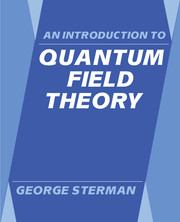Book contents
- Frontmatter
- Contents
- Preface
- PART I SCALAR FIELDS
- PART II FIELDS WITH SPIN
- PART III RENORMALIZATION
- PART IV THE NATURE OF PERTURBATIVE CROSS SECTIONS
- 12 Perturbative corrections and the infrared problem
- 13 Analytic structure and infrared finiteness
- 14 Factorization and evolution in high-energy scattering
- 15 Epilogue: Bound states and the limitations of perturbation theory
- APPENDICES
- References
- Index
15 - Epilogue: Bound states and the limitations of perturbation theory
Published online by Cambridge University Press: 05 August 2012
- Frontmatter
- Contents
- Preface
- PART I SCALAR FIELDS
- PART II FIELDS WITH SPIN
- PART III RENORMALIZATION
- PART IV THE NATURE OF PERTURBATIVE CROSS SECTIONS
- 12 Perturbative corrections and the infrared problem
- 13 Analytic structure and infrared finiteness
- 14 Factorization and evolution in high-energy scattering
- 15 Epilogue: Bound states and the limitations of perturbation theory
- APPENDICES
- References
- Index
Summary
Factorization enables us to derive inclusive high-energy cross sections directly from the perturbative expansion in terms of elementary fields. Yet, the ubiquity of bound states in hadronic physics demands that we further bridge the gap between them and elementary fields. Similarly, to describe bound states such as positronium in QED fully, it is necessary to include field-theoretic corrections.
Under some circumstances, bound state masses and matrix elements are well understood in terms of infinite sums of Feynman diagrams, or of solutions to integral equations based on perturbation theory. The perturbative expansion can suggest expressions for bound state matrix elements, even when the corresponding wave functions are unknown. Certain quantities, however, do not seem accessible to perturbation theory, even summed to all orders. Among these are the matrix elements that appear in the operator product expansion in QCD, and the masses of light hadrons.
The Bethe–Salpeter equation and wave functions
The derivations that led to the reduction formulas eqs. (2.97) and (7.88) are not limited to elementary particles. It is easy to check that any asymptotic single-particle state produces a pole in any Green function with fields of the appropriate quantum numbers. Let us see, however, how such a pole can be generated in the language of perturbation theory.
- Type
- Chapter
- Information
- An Introduction to Quantum Field Theory , pp. 492 - 501Publisher: Cambridge University PressPrint publication year: 1993



